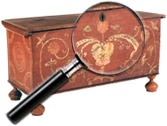|
|
Dr. Elisha Kent Kane
Elisha Kent Kane contracted rheumatic fever during his second year of university. This doubtless led him to the pursuit of medical studies (by age twenty-two, he had published a study of early pregnancy detection in the American Journal of Medical Sciences). Because of this training, he possessed a clear understanding of the clinical implications of the persistent endocarditis left by the disease. Without the benefit of antibiotics, it was the [...] Click here to continue reading.
Lumiere Tri-Chromie Process
The Tri-Chromie or three-color process basically uses black and white panchromatic film with three different colored filters to achieve a multi-colored image. The Lumiere Tri-Chromie process dates from about 1893. It was part of their color experimentation that eventually led to the Autochrome. It is not believed that the Tri-Chromie process was never sold commercially.
Information courtesy of Stereographica.com.
Albumen Prints
Albumen prints were a major nineteenth century photographic development in printing positive prints of high quality. Its discovery in 1850 followed experimentation with a number of less successful approaches.
The photographic process known as Salted Paper Prints was developed in 1834 by William Henry Fox Talbot, an Englishman. The process, though revolutionary for its time, had its limitations due to the use of paper for the negative and also for the printed [...] Click here to continue reading.
Trenton Falls, New York
The geologic feature known as Trenton Falls is located in Oneida County, New York and was a major tourist destination in the nineteenth century. The falls comprise several drops of the West Canada Creek totaling 270 feet over a series of limestone ledges creating seven major falls, including: Upper High Falls, Lower High Falls, Village Falls, Cascade of the Alhambra, Sherman Falls, Bridal Veil Falls and Mill Dam Falls.
Beginning [...] Click here to continue reading.
David Dixon Porter, Admiral USN (1813-1891)
Born at Chester, Pennsylvania, June 8, 1813, the son of David and Evelina Anderson Porter. David Dixon Porter married Georgie Ann Patterson, March 10, 1839 and they had ten children, including Lieutenant Colonel Carlile Patterson Porter.
He was commissioned Lieutenant, U.S. Navy, 1841, and commanded a landing party of 70 seamen and captured Fort Tabasco, Mexico, in 1847; he commanded the steamer Panama, 1849, and made a voyage [...] Click here to continue reading.
Stanhopes
The Stanhope viewer combines a miniature microphotographic lens and photograph hidden in a mid-nineteenth century novelty item.
The Stanhope takes its name from the inventor of its lens, Charles the 3rd Earl of Stanhope (1753 to 1816). He first developed a basic handheld viewer with two lens of unequal curvature. The design would later be modified to use one curved magnifying lens and one flat lens, although Stanhope himself died long before this [...] Click here to continue reading.
Salted Paper Prints
It was Englishman William Henry Fox Talbot who in 1834 developed the photographic process that would become known as Salted Paper Prints. The process involved several steps. First, a good quality writing paper was soaked in a solution of sodium chloride or common salt and then was allowed to dry. After the paper had dried it was covered with a 20% solution of silver nitrate. This solution adhered to the paper’s [...] Click here to continue reading.
Magic Lanterns & Slides
The magic lantern is an early form of slide projector using a focusing lens and light source to project an image. The images are on glass and either hand-painted, lithographed or photographic.
The earliest forms of magic lanterns appeared in the 1400′s and through development they were transformed into the lanterns we recognise today. Because of their age, unlike other forms of collectible photographica, it is impossible to say [...] Click here to continue reading.
Edward & Henry T. Anthony
Edward Anthony trained as a civil engineer before turning to photography. He was educated at Columbia University where he studied science. Anthony took an interest in photography from the time it was first introduced to the U.S. in 1839. He studied under one of the pioneers of American photograph, Samuel Morse. Helped by his sound scientific background Anthony soon became an accomplished Daguerreotype photographer.
By 1842 Anthony was [...] Click here to continue reading.
Cabinet Cards
In 1863 the cabinet card photographic image was introduced. This format, in many ways, was similar to its predecessor, the carte de visite, a paper albumen print mounted on card. The principal difference between the two formats was their size. The cabinet card mount measured approximately 6.5 inches by 4.25 inches. The images were slightly smaller measuring approximately 5.5 inches by 4 inches. Sometime in the 1870′s a new larger sized card [...] Click here to continue reading.
|
Recent Articles
- Charles Alfred Meurer – American Artist & Tromp L’Oeil Artist
- Sendak, Maurice – American Artist & Writer
- Godie, Lee – American Artist
- Davis, Vestie – American Artist
- Bartlett, Morton – American Artist
- Mackintosh, Dwight – American Artist
- Evans, Minnie Jones – African-American Artist
- Mumma, Ed (Mr. Eddy) – American Artist
- Nice, Don – American Artist
- Savitsky, John (Jack) – American Artist
- Gordon, Harold Theodore (Ted) – American Artist
- Dial, Thornton – African-American Artist
- Doyle Sam – American Artist
- Johnson, Lester Frederick – American Artist
- Finster, Howard – American Artist
|
|
